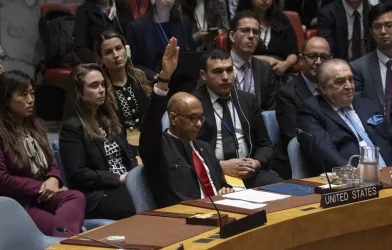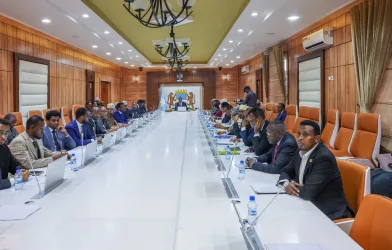
People protest the Muslim travel ban outside of the U.S. Supreme Court on June 26, 2018, in Washington, DC. (Photo by Deng Min/China News Service/VCG via Getty Images) GETTY
During the 2016 presidential campaign, Donald Trump called for “a total and complete shutdown of Muslims entering the United States.” Not all Muslims were stopped from coming to America but an analysis of the Trump administration’s travel ban shows many fewer legal immigrants and temporary visa holders came to America in 2018 from the 5 majority-Muslim nations targeted by the ban. Moreover, new information obtained from the State Department reveals even fewer “waivers” from the travel ban have been granted than government statistics indicate.
“The Supreme court upheld the Trump administration’s travel ban 5-4, affirming the president’s power over matters of national security,” reported Politico on June 26, 2018. “The latest iteration of the ban includes restrictions against five majority-Muslim nations – Iran, Libya, Somalia, Syria and Yemen. North Korea and Venezuela are also on the list. . . . While the text of the order does not mention religion, critics say the policy reflects anti-Muslim prejudice – with North Korea and Venezuela added as window dressing.”
The best way to measure the impact of the executive order is to compare immigration data in FY 2016 to FY 2018. The executive order was one of the first major actions Trump took after he became president but was not in effect throughout all of FY 2017. It was later revised and issued as a separate executive order (or presidential proclamation).
Table 1: Immigrant Visas Issued for Travel Ban Countries
| Country | FY 2016 | FY 2018 | Decline | %Decline FY 2016 to FY 2018 |
| Iran | 7,727 | 1,449 | -6,278 | -81% |
| Libya | 383 | 139 | -244 | -64% |
| Somalia | 1,797 | 546 | -1,251 | -70% |
| Syria | 2,633 | 838 | -1,795 | -68% |
| Yemen | 12,998 | 1,195 | -11,803 | -91% |
| Total | 25,538 | 4,167 | -21,371 | -84% |
Source: U.S. Department of State, National Foundation for American Policy.
A National Foundation for American Policy analysis of the data shows a decline of 84% in the number of immigrant (for permanent resident) visas issued to citizens of the five majority-Muslim countries. The decline was 78% for temporary visas. The number of Iranians who received immigrant visas dropped from 7,727 in FY 2016 to 1,449 in FY 2018, an 81% decline. In FY 2018, 11,803 fewer immigrants from Yemen were approved visas than in FY 2016, a drop of 91%. The declines are similar, if somewhat smaller, for potential immigrants from Libya, Somalia and Syria.
For people from Iran, Libya, Somalia, Syria and Yemen it has also become far more difficult to come to America on a temporary visa to visit family members or for other reasons, the data show. In FY 2018, the United States approved 23,390 fewer temporary visas for Iranians than in FY 2016, a decline of 80%. Temporary visas for people from Yemen dropped 78% between FY 2016 and FY 2018.
Table 2: Temporary Visas Issued for Travel Ban Countries
| Country | FY 2016 | FY 2018 | Decline | %Decline FY 2016 to FY 2018 |
| Iran | 29,404 | 6,014 | -23,390 | -80% |
| Libya | 2,307 | 925 | -1,382 | -60% |
| Somalia | 451 | 207 | -244 | -54% |
| Syria | 9,096 | 2,131 | -6,965 | -77% |
| Yemen | 5,203 | 1,121 | -4,082 | -78% |
| Total | 46,461 | 10,398 | -36,063 | -78% |
Source: U.S. Department of State, National Foundation for American Policy.
A major source of contention is whether the travel ban provides a realistic opportunity for individuals to obtain waivers. Section 3 of the executive order states “(i) A waiver may be granted only if a foreign national demonstrates to the consular officer’s or CBP [Customs and Border Protection] official’s satisfaction that: (A) denying entry would cause the foreign national undue hardship; (B) entry would not pose a threat to the national security or public safety of the United States; and (C) entry would be in the national interest.” Using a Freedom of Information Act (FOIA) request, the International Refugee Assistance Project (IRAP) obtained a copy of the guidance consular officers use to decide whether to grant a waiver. (IRAP gave a copy to Vox.)
If one looks at a recently released State Department report, it appears in FY 2018 approximately 6% of people refused visas because of the travel ban overcame the ineligibility finding. For immigrants, the report lists 15,384 ineligibility findings (i.e., the grounds for a visa refusal) based on the travel ban and 923 ineligibility overcomes (meaning people were later granted visas). For nonimmigrants (individuals seeking temporary visas) the report lists 21,645 ineligibility findings related to the travel ban and 1,309 ineligibility overcomes. An “overcome” might not take place in the same fiscal year it was sought by the applicant.
Table 3: FY 2018 Ineligibility Findings on Travel Ban Executive Order
| Ineligibility Finding | Ineligibility Overcome | % Overcome | |
| Immigrant Visa | 15,384 | 923 | 6% |
| Temporary Visa | 21,645 | 1,309 | 6% |
Source: U.S. Department of State, National Foundation for American Policy. “A refusal can be overcome by evidence that the ineligibility does not apply, by approval of a waiver, or by other relief as provided by law,” according to the State Department.
There is an important caveat to these numbers. I asked the State Department if everyone listed as having “overcome” the travel ban did so because of a waiver. The State Department’s response? On background: “For the purposes of the Department’s Report of the Visa Office a refusal can be overcome by evidence that the ineligibility does not apply, by approval of a waiver, or by other relief as provided by law.” In other words, this means that it is likely fewer than 6% of those who overcame a travel ban-related refusal did so because of a waiver. Individuals may have overcome the refusal for other reasons, such as the ban did not actually apply to them.
“While this statistic makes it appear that about 6% of cases are approved for waivers, the State Department has affirmed that these statistics include cases where the applicant was able to overcome the denial by showing that the applicant was not subject to the ban. There are numerous exceptions to the ban, such as dual nationals who can travel on a passport of a country not covered by the sanctions. Therefore, the actual percentage of cases approved for discretionary waivers is probably lower than 6%, and may be significantly lower,” said Jeffrey Gorsky, former Chief of the Legal Advisory Opinion section of the Visa Office in the U.S. Department of State, in an interview. I shared a copy with him of the State Department’s response.
“I have first-hand knowledge of how difficult it is to obtain a waiver. I have applied for several on behalf of my clients – all were denied,” said Gorsky, now a senior counsel at the law firm of Berry Appleman & Leiden LLP. “One case involved an employee of a major U.S. company with a Syrian nationality who was not born in and had never lived in Syria. The company wanted her to come for a short business visit to be trained in their annual new product launch so that she could work on expanding their Middle East market share. The executive order states that ‘significant business obligations’ is one basis for waiver consideration. Her waiver application was summarily denied.”
While it is common to view issues such as the travel ban in isolation, it may make more sense to see the travel ban as part of a group of policies designed to reduce legal immigration to the United States. The presidential directive on “extreme vetting” of visas, the Buy American and Hire American executive order against high-skilled professionals and changes to “public charge” ineligibility, along with the travel ban and other policies, come from the same (restrictive) viewpoint on immigration.
The Cato Institute’s David Bier has pointed to broad drops in immigration from majority-Muslim countries not covered by the travel ban and an over 90% decline in the admission of Muslim refugees. On refugees, the Trump administration could argue it is not singling out Muslim refugees, since it is also admitting very few Christian refugees from the Middle East, note refugee advocates, yet administration officials are unlikely to offer that argument publicly.
The Washington Post’s Jason Rezaian recently produced a poignant short film about American citizens who are separated from their Iranian-born spouses because of the travel ban, raising additional questions about the validity of the waiver process and the policy justification for keeping spouses apart from one another. “Because I cover Iran for the Washington Post I’ve been flooded with messages from Americans separated from their husbands and wives, terrified they’ll never be together,” said Rezaian in the film.
Some people, including the president, have argued America has “open borders” or
By: Stuart Anderson
Forbes







